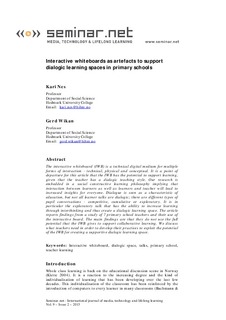Interactive whiteboards as artefacts to support dialogic Learning Spaces in primary schools
Journal article, Peer reviewed
Permanent lenke
http://hdl.handle.net/11250/134618Utgivelsesdato
2013Metadata
Vis full innførselSamlinger
Originalversjon
Nes, Kari, & Wikan, Gerd Nora. (2013). Interactive whiteboards as artefacts to support dialogic Learning Spaces in primary schools. Seminar.net : Media, technology and lifelong learning, 9(2), 13. 10.7577/seminar.2387Sammendrag
The interactive whiteboard (IWB) is a technical digital medium for multiple
forms of interaction - technical, physical and conceptual. It is a point of departure for this article that the IWB has the potential to support learning, given that embedded in a social constructive the teacher has a dialogic teaching style. Our research is
learning philosophy implying that
interaction between learners as well as learners and teacher will lead to increased insights for everyone. Dialogue is seen as a characteristic of education, but not all learner talks are dialogic; there are different types of pupil conversations - competitive, cumulative or exploratory. It is in particular the exploratory talk that has the ability to increase Learning through interthinking and thus create a dialogic learning space. The article reports findings from a study of 7 primary school teachers and their use of
the interactive board. The main findings are that they do not use the full potential that the IWB gives to support collaborative learning. We discuss what teachers need in order to develop their practices to exploit the potential of the IWB for creating a supportive dialogic learning space.
Beskrivelse
Fagfellevurdert artikkel publisert i Seminar.net: International journal of media, technology & lifelong learning, 2013.
